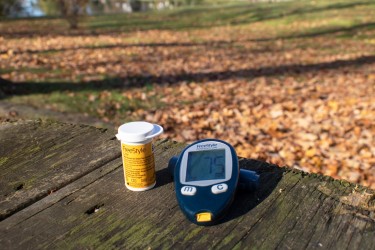Glucose self-monitoring in non-insulin-treated patients with type 2 diabetes in primary care settings: A randomized trial

Laura A Young, John B Buse, Mark A Weaver, Maihan B Vu, C Madeline Mitchell, Tamara Blakeney, Kimberlea Grimm, Jennifer Rees, Franklin Niblock, Katrina E Donahue, Monitor Trial Group
Abstract
Importance: The value of self-monitoring of blood glucose (SMBG) levels in patients with non-insulin-treated type 2 diabetes has been debated.
Objective: To compare 3 approaches of SMBG for effects on hemoglobin A1c levels and health-related quality of life (HRQOL) among people with non-insulin-treated type 2 diabetes in primary care practice.
Design, setting, and participants: The Monitor Trial study was a pragmatic, open-label randomized trial conducted in 15 primary care practices in central North Carolina. Participants were randomized between January 2014 and July 2015. Eligible patients with type 2 non-insulin-treated diabetes were: older than 30 years, established with a primary care physician at a participating practice, had glycemic control (hemoglobin A1c) levels higher than 6.5% but lower than 9.5% within the 6 months preceding screening, as obtained from the electronic medical record, and willing to comply with the results of random assignment into a study group. Of the 1032 assessed for eligibility, 450 were randomized.
Interventions: No SMBG, once-daily SMBG, and once-daily SMBG with enhanced patient feedback including automatic tailored messages delivered via the meter.
Main outcomes and measures: Coprimary outcomes included hemoglobin A1c levels and HRQOL at 52 weeks.
Results: A total of 450 patients were randomized and 418 (92.9%) completed the final visit. There were no significant differences in hemoglobin A1c levels across all 3 groups (P = .74; estimated adjusted mean hemoglobin A1c difference, SMBG with messaging vs no SMBG, -0.09%; 95% CI, -0.31% to 0.14%; SMBG vs no SMBG, -0.05%; 95% CI, -0.27% to 0.17%). There were also no significant differences found in HRQOL. There were no notable differences in key adverse events including hypoglycemia frequency, health care utilization, or insulin initiation.
Conclusions and relevance: In patients with non-insulin-treated type 2 diabetes, we observed no clinically or statistically significant differences at 1 year in glycemic control or HRQOL between patients who performed SMBG compared with those who did not perform SMBG. The addition of this type of tailored feedback provided through messaging via a meter did not provide any advantage in glycemic control.
This article was featured in the October 7, 2021, Lunch and Learn discussion
In this segment of the recording of the October 7, 2021, online Lunch and Learn discussion, one of the authors of this paper, Katrina Donahue, MD, MPH, professor of Family Medicine at the University of North Carolina School of Medicine, presented the paper.
Policy Discussion Highlights from the Discussion:
- Glucose self-monitoring
- After 1 year there were no clinically or statistically significant differences in glycemic control or quality of life between patients who engaged in glucose self-monitoring and patients who did not.
- 2020 standards of medical care in diabetes, published by the American Diabetes Association (ADA), reports that in people with type 2 diabetes not using insulin, routine glucose monitoring may be of limited additional clinical benefit.
- Policy Implications:
- In patients with type 2 diabetes not using insulin, the American Academy of Family Physicians (AAFP) and Society of General Internal Medicine (SGIM) don’t recommend daily home glucose monitoring.
- Explore other recommendations from the Choosing Wisely Campaign.
Full Resource/Source: JAMA Internal Medicine
Secondary menu
Copyright © 2024 Primary Care Collaborative



